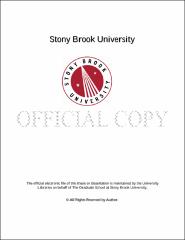| dc.identifier.uri | http://hdl.handle.net/11401/77624 | |
| dc.description.sponsorship | This work is sponsored by the Stony Brook University Graduate School in compliance with the requirements for completion of degree. | en_US |
| dc.format | Monograph | |
| dc.format.medium | Electronic Resource | en_US |
| dc.language.iso | en_US | |
| dc.publisher | The Graduate School, Stony Brook University: Stony Brook, NY. | |
| dc.type | Dissertation | |
| dcterms.abstract | SRSF1 is a prototypical member of the Ser/Arg-rich family of splicing factors. In addition to its involvement in constitutive and alternative splicing, SRSF1 regulates many other aspects of RNA metabolism, including transcription, mRNA export, stability and decay, translation, and miRNA processing. In addition, SRSF1 contributes to maintaining genomic stability, and is an important regulator of the cell cycle and cell viability. In spite of multiple post-transcriptional and translational mechanisms for SRSF1 auto-regulation, it is frequently upregulated in cancer. Here we focus on studying the regulation of SRSF1 expression and function. We have found SRSF1 to be a direct transcriptional target of the oncoprotein MYC, suggesting a mechanism for SRSF1 upregulation in a subset of tumors with elevated MYC levels. MYC activates transcription of SRSF1 through two non-canonical E-boxes in the SRSF1 promoter. MYC activity alters the splicing profile of some but not all of SRSF1's splicing targets. Furthermore, SRSF1 induction by MYC is important for MYC-mediated transformation. While investigating the SRSF1 protein interactome using quantitative mass spectrometry, we identified a novel function of SRSF1. SRSF1 interacts with the ribosomal protein RPL5 and the E3 ubiquitin ligase MDM2 upon induction of ribosomal stress. This results in decreased ubiquitylation and increased stability of the tumor-suppressor protein p53, which then activates the cellular stress response. We previously showed that upregulation of SRSF1 leads to transformation of immortalized cells. However, upon overexpression in primary fibroblasts, SRSF1 recruits the RPL5-MDM2 complex and stabilizes p53, resulting in oncogene-induced senescence, a tumor-protective response. Our studies therefore identify a transcription factor responsible for SRSF1 overexpression in certain tumors, and an anti-tumorigenic mechanism through which cells initially respond to SRSF1 overexpression. | |
| dcterms.available | 2017-09-20T16:53:03Z | |
| dcterms.contributor | REICH, NANCY | en_US |
| dcterms.contributor | KRAINER, ADRIAN R | en_US |
| dcterms.contributor | SPECTOR, DAVID | en_US |
| dcterms.contributor | HEARING, PATRICK | en_US |
| dcterms.contributor | EGEBLAD, MIKALA | en_US |
| dcterms.contributor | VAKOC, CHRISTOPHER. | en_US |
| dcterms.creator | DAS, SHIPRA | |
| dcterms.dateAccepted | 2017-09-20T16:53:03Z | |
| dcterms.dateSubmitted | 2017-09-20T16:53:03Z | |
| dcterms.description | Department of Genetics. | en_US |
| dcterms.extent | 111 pg. | en_US |
| dcterms.format | Monograph | |
| dcterms.format | Application/PDF | en_US |
| dcterms.identifier | http://hdl.handle.net/11401/77624 | |
| dcterms.issued | 2015-08-01 | |
| dcterms.language | en_US | |
| dcterms.provenance | Made available in DSpace on 2017-09-20T16:53:03Z (GMT). No. of bitstreams: 1
DAS_grad.sunysb_0771E_11472.pdf: 2854900 bytes, checksum: abab2878fb83df53f34ad6a2968e33eb (MD5)
Previous issue date: 2013 | en |
| dcterms.publisher | The Graduate School, Stony Brook University: Stony Brook, NY. | |
| dcterms.subject | Molecular biology | |
| dcterms.title | Regulation and Function of Oncogenic Splicing Factor SRSF1 | |
| dcterms.type | Dissertation | |

